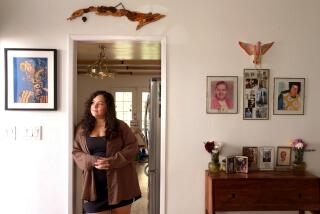Hands-On Experience : Program Teaches Trainees to Coax Model Cars--and Jobs--From Clay
- Share via
John Grimes had never made anything much bigger than an ashtray in ceramics class, but there he stood, digging clay from beneath his nails and examining the lines of the full-size automobile model he’d been carving all week.
Grimes, an 18-year-old Fountain Valley High School graduate, was one of eight candidates for a trainee job in one of the most exclusive trades in the automotive business: model making.
Candidates are evaluated during three-week programs run periodically at Calty Design Research, Toyota Motor Co.’s key North American research and design studio.
Three of the candidates in the most recent session received job offers, but there weren’t any losers, Calty executives said. The program gave the group a close-up look at a career path few people know exists: translating the sometimes otherworldly musings of automobile designers into three-dimensional realities.
“I didn’t know you could get paid to make car models,” said Reuben Chavez, also 18 and a June graduate of Los Alamitos High School.
You can--if you can breathe life into clay. Trainee modelers start at about $500 a week, but top model makers command annual salaries of $80,000 or more. There probably are no more than two dozen job openings a year, though, and just getting accepted for training is difficult.
They don’t teach model making at the local community college, and even rigorous programs such as the prestigious transportation design schools at Art Center College of Design in Pasadena offer only a few hours of model-making training to students hoping to earn designer credentials.
Calty runs its program when it needs a new trainee--there have been six courses in the last eight years, including two this year. A third of the 30 candidates who have been through the program are working as modelers.
“We used to be like all the other studios, dependent on hiring people who’d been trained in Michigan,” said David Hackett, Calty studio director. “But we got people who’d come here and just couldn’t handle the culture shock or the price of housing, so we decided to bite the bullet and hire people who already lived here. And that meant doing our own training.”
The models turned out in auto design studios are crafted from the ground up. Although models of clay spread on steel or wooden frames are most common, modelers also learn to use fiberglass, plastics and foam.
The finished products, hand-smoothed into complex shapes and coated with special paints that replicate the gleam of enamel on metal, are just part of the long, complex process that starts at the drawing table and ends on the showroom floor.
But they are an essential part, enabling designers to finally see what had previously existed only in their minds, and providing marketing executives, manufacturing engineers and focus groups something tangible to work with.
Modelers take the drawings from the designer’s table and build three-dimensional representations of the vehicle. Trainees do it exactly as drawn, while more advanced modelers become a part of the design team, telling the designer what works and what doesn’t, suggesting subtle alterations in line and shape that make the vehicle more pleasing to the eye.
In some of the largest studios, sophisticated modeling software enables designers to develop and refine their work in 3-D on the computer screen. But modelers and designers say computers will never put human modelers out of business.
“We’re the 3-D masters,” said Lanny Zamora, an advanced model maker at the secluded Newport Beach studio. “We can tell them what’s possible and what’s not possible and why something that looked good on paper just doesn’t work. A lot of times, the designer just doesn’t understand that until we move some clay around and show them.”
In the past, most of the Calty modeler candidates have come out of art and automotive programs at area community colleges and trade schools. This year, though, the studio sought high school graduates as well after joining the Orange County Vital Link program. The business and education partnership “helps prepare kids for trades and careers that don’t require college,” said Zoe Sessler, Calty’s human relations director.
This year’s group ranged in age from 17 to 24, and Ramsey Conder, an 18-year-old graduate of Edison High School in Huntington Beach, was among those hired by the studio. The others selected as modeler trainees were Gustavo Perez, 21, of Anaheim and Jason Pyle, 24, who heard about the program while attending a trade institute in San Bernardino.
Studio chief Hackett said the program has been invaluable. Of the 15 modelers and trainees now working at Calty, 10 have been were picked from the studio’s training classes.
“It’s been quite an experience,” said Perez, a longtime car buff who attended Cypress College’s auto body technician program.
“It’s completely different from body work,” he said. “When you’re working with metal, it shows you what it was, and all you’ve got to do is get it back into shape by fixing the bent parts. With modeling, you start with nothing but a drawing. You’ve got to be able to see what the clay will be and then make it be that.”






